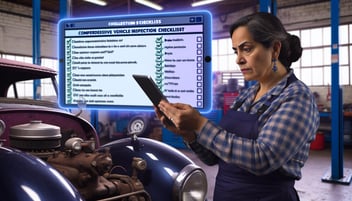For businesses involved in the storage and distribution of goods, warehouse safety remains a top priority. Ensuring that warehouse procedures are safe and compliant with industry standards is vital for the safety of employees. This involves compliance with routine inspections and regular maintenance of storage facilities.
Regular pallet racking inspections are integral to warehouse safety. Pallet racking, the storage system used extensively in warehouses to organize and store goods, needs to be utilized efficiently and safely as it plays a crucial role in the warehouse industry.
Understanding The Importance Of Pallet Racking
Pallet racking systems constitute the core infrastructure of numerous warehouse operations. These storage systems, widely utilized in warehouses, play a crucial role in warehouse operations. Their efficient, safe usage is essential in maintaining industry standards. A minor issue with a rack, if left unchecked, could lead to significant problems, impacting both safety and productivity.
Visualize a worker going about their everyday tasks when suddenly, a neglected and deteriorating pallet rack collapses. The aftermath could be disastrous, both in terms of human life and material loss. Transitioning from this grim scenario, it becomes clear that regular inspections of pallet racking systems are critical.
Setting A Routine For Inspections
Ignoring routine pallet racking inspection can lead to tangible and serious risks. Some warehouse injuries, which lead to human cost, operational downtime, and lost revenue, are attributable to improper storage or racking system failures.
-
Risk Detection: Regular inspections serve as a proactive measure to identify and mitigate potential risks linked to improper storage or racking system failures.
-
Cost And Safety: Regular inspections not only prevent accidents but can also save costs. Timely detection and resolution of issues can help avoid such expenditures.
Understanding the substantial risks of ignoring routine inspections, it's time to delve into the creation of an efficient inspection routine that can prevent such dangers.
Creating An Inspection Routine
A well-established inspection routine serves as an initial barrier against potential dangers. Internal monthly checks by warehouse staff, coupled with comprehensive annual inspections by qualified personnel, can form a solid safety net. Imagine inspections as regular health check-ups for the warehouse.
Just as timely detection of health issues can prevent a major illness, identifying and rectifying faults early can prevent accidents.
-
Monthly Checks: Warehouse staff should conduct checks monthly. This internal examination can catch minor damages or issues that could escalate if left unattended.
-
Annual Inspections: Comprehensive yearly inspections by a competent person can provide an in-depth analysis of the racking systems, helping to maintain them at optimal safety levels.
With an established inspection routine, the active participation of the warehouse staff becomes the next factor. They serve as the first line of defense.
Employees: The First Line Of Defense
The active participation of warehouse staff is essential for upholding safety standards. Warehouse staff are the eyes and ears on the ground. Encouraging them to report any issues observed with the pallet racking systems ensures early detection of potential problems. However, to do so, they need the right training.
-
Observation: Staff should be encouraged to report any noticeable damage or issues with the pallet racking systems.
-
Training: Investing in regular training sessions can equip your workforce with the knowledge and skills needed to identify potential problems.
Now, let's explore how this well-trained and observant team can positively impact employee safety.
The Impact On Employee Safety
The primary goal of regular pallet racking inspections is to nip any potential dangers in the bud, thereby preventing accidents. Inspections focus on identifying risks and taking corrective actions. From bent or dented racks to loose or missing parts, overloaded racks, and uneven loads, inspectors look for any signs that could indicate a risk.
Addressing these risks head-on not only makes the warehouse safer for employees but also boosts the employees' confidence, knowing that their safety is a priority.
-
Looking For Signs: Inspectors look for bent or dented racks, loose or missing parts, overloaded racks, or uneven loads.
-
Preventing Accidents: Timely resolution of these issues can significantly reduce the risk of accidents, making the warehouse a safer place for employees.
However, overlooking these inspections can lead to severe outcomes. Let's discuss the potential consequences.
Consequences Of Neglecting Inspections
While inspections are pivotal for upholding safety and productivity, overlooking them can result in grave consequences. Overlooking inspections can lead to severe consequences.
Despite the clear benefits of regular checks, some businesses fail to prioritize them, which invites grave outcomes. Rack collapses, often resulting from neglected maintenance, can lead to serious injuries or even fatalities.
-
Injuries And Accidents: Warehouse workers experience an injury or illness each year, often resulting from rack collapses due to neglected maintenance, which can lead to serious injuries or even fatalities.
-
Legal Consequences: Non-compliance with safety regulations can result in hefty fines and legal issues.
Final Thoughts
Regular inspections of pallet racking systems represent more than just a point on a safety checklist; they’re an integral part of sustaining a safe and productive warehouse environment. A pallet racking inspection will go a long way in helping avoid risks, prevent accidents, save costs, and above all, protect the well-being of employees. The severe legal and financial consequences of neglecting this vital process underscore the importance of proactive action over-reactive measures. A commitment to safety is, after all, a commitment to the people who make everything possible.

-Jul-18-2023-12-16-33-2580-PM.png?width=425&length=350&name=Untitled%20design%20(1)-Jul-18-2023-12-16-33-2580-PM.png)


%20(1).webp?width=352&name=Blog%20Graphic%20(8)%20(1).webp)

Leave a Comment